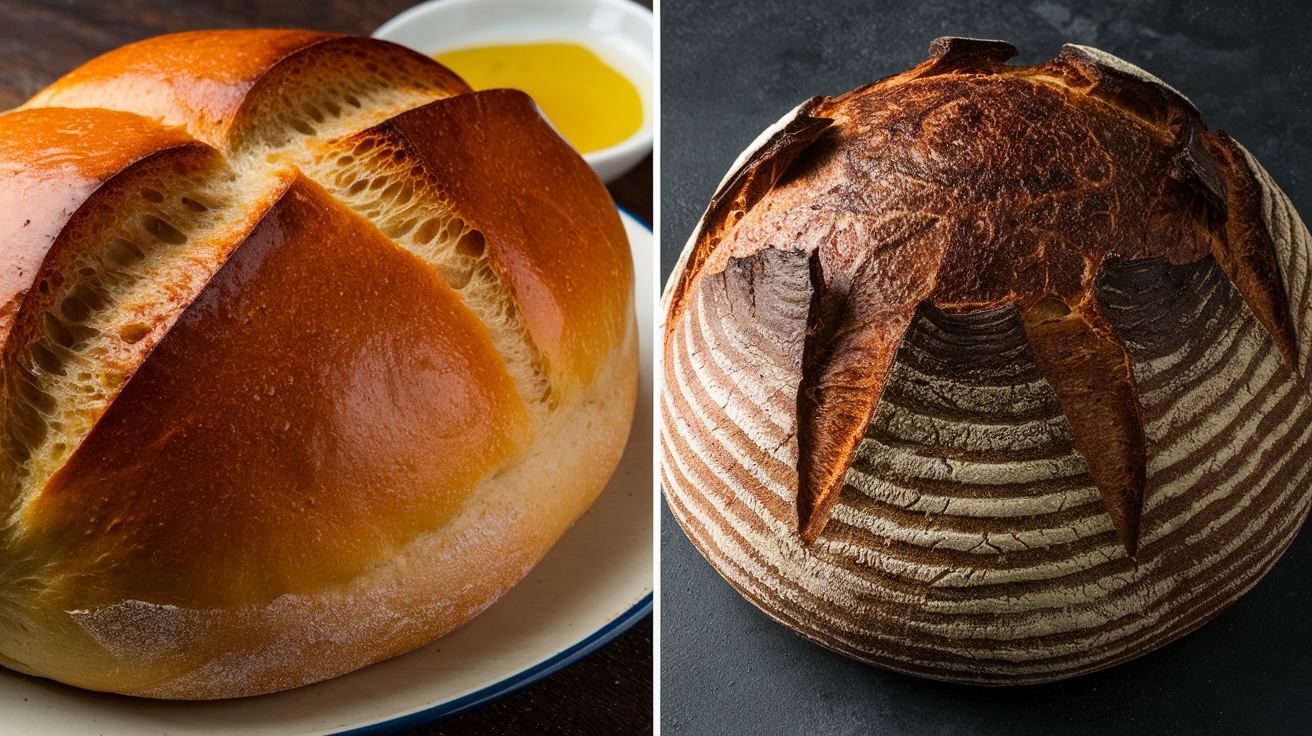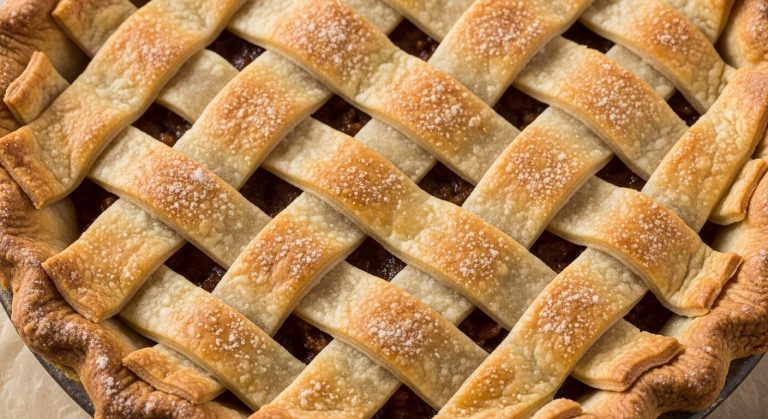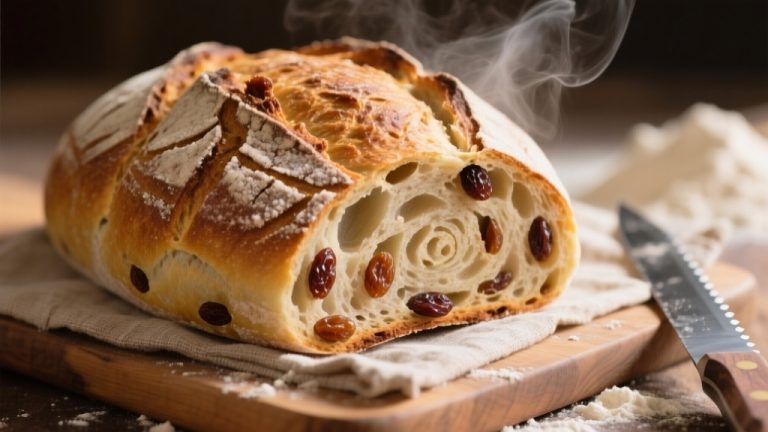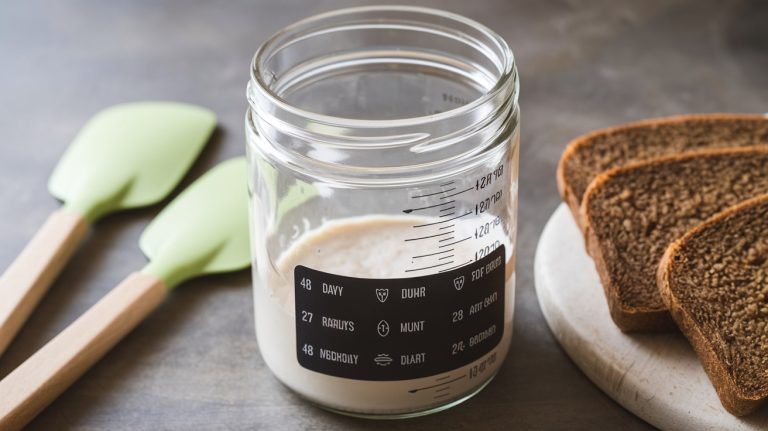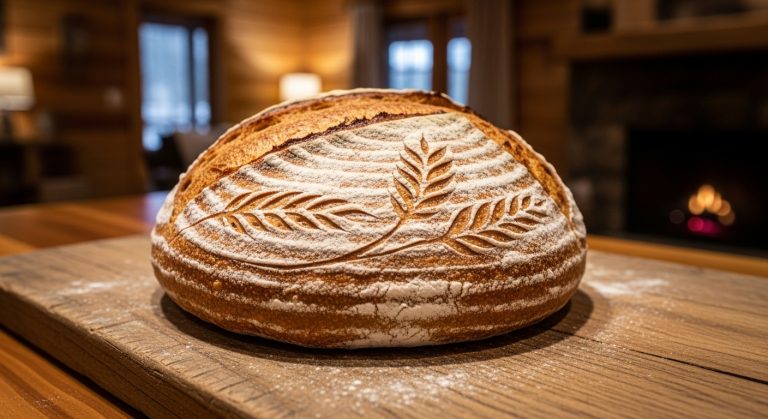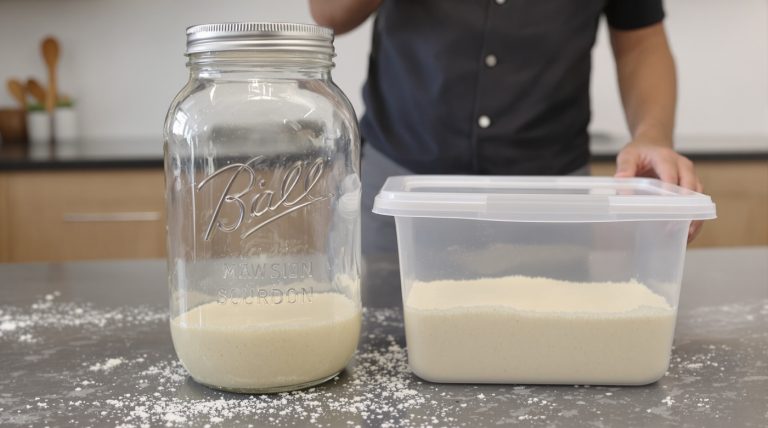Italian Pane Di Casa Vs Sourdough: What’s the Difference?
When comparing Pane Di Casa and sourdough, you’ll notice each has its own charm. Pane Di Casa, made with commercial yeast, offers a mild flavor and dense, crunchy crust, perfect for soups and stews.
On the other hand, sourdough features a chewy texture and a distinctive tang from its natural fermentation process, making it great for gourmet pairings like rich cheeses. Nutritionally, sourdough shines with improved digestibility and lower glycemic index benefits, while Pane Di Casa may have higher sodium levels.
Both breads have unique qualities, and there’s much more to uncover about their culinary uses.
Key Takeaways
- Pane Di Casa is leavened with commercial yeast for a quicker rise, while sourdough uses natural starters for a longer fermentation process.
- Sourdough has a chewy crust and open crumb structure, while Pane Di Casa features a dense crumb and crunchy crust.
- Sourdough’s fermentation process contributes to a distinct tangy flavor, whereas Pane Di Casa offers a milder taste.
- Sourdough may improve digestibility and has a lower glycemic index than Pane Di Casa, which may contain preservatives and higher sodium.
- Both breads are versatile, with sourdough pairing well with rich foods and Pane Di Casa excelling in soaking up broths in soups and stews.
Differences Between Pane Di Casa and Sourdough
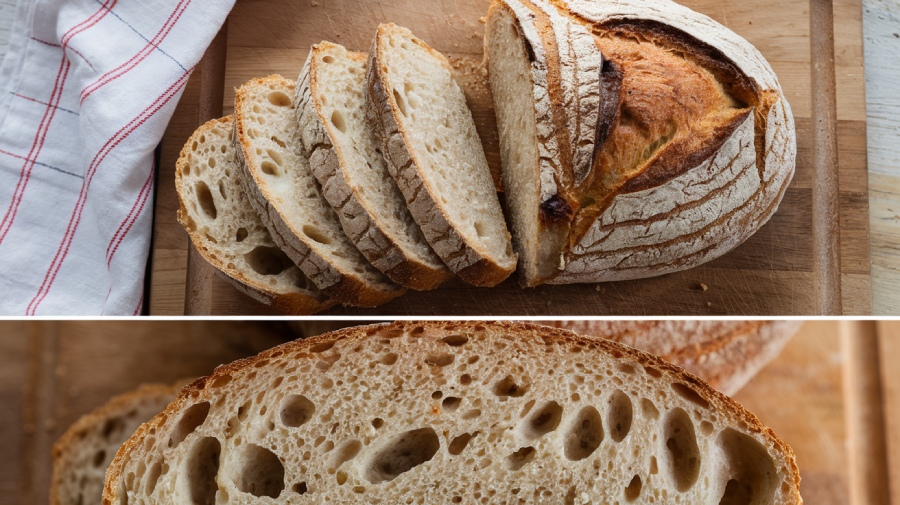
When comparing Pane Di Casa and sourdough, you’ll often notice significant differences that set them apart. One of the most striking contrasts lies in their fermentation methods. While Pane Di Casa is leavened with commercial yeast, resulting in a quicker rise, sourdough relies on natural starters filled with wild yeast and bacteria, leading to a much longer fermentation process.
This difference impacts the texture of the bread; Pane Di Casa features a dense crumb and a crunchy crust, whereas sourdough has a chewy crust and an open crumb structure. The fermentation process in sourdough enhances flavor and promotes the growth of beneficial bacteria, contributing to improved digestive health.
Flavor plays an essential role too. Pane Di Casa boasts a mild flavor with its shorter fermentation time, while sourdough develops a distinct tanginess through its prolonged fermentation. The baking techniques also differ—Pane Di Casa is baked in a hot oven for that crackling exterior, while sourdough achieves a thicker, crunchier crust thanks to steam retention during baking.
On the nutritional side, sourdough may offer improved digestibility and a lower glycemic index, making it a healthier choice compared to Pane Di Casa, which might contain preservatives if commercially produced.
Each bread has unique qualities, appealing to different tastes and preferences.
Origins of Pane Di Casa
Pane Di Casa, often referred to as the “bread of the house,” boasts a rich history that stretches back centuries in Italy. This beloved bread is deeply rooted in Italian cuisine, symbolizing hospitality and the warmth of home. Its origins reveal a simple yet profound connection to local traditions and ingredients.
Imagine the scene where Pane Di Casa takes center stage:
- Families gather around a rustic wooden table, sharing stories and laughter.
- The aroma of freshly baked bread wafts through the air, inviting everyone to indulge.
- A crispy crust breaks open, revealing a fluffy interior that’s perfect for sopping up rich sauces.
Historically, Pane Di Casa was crafted by home bakers who utilized natural fermentation methods, allowing the dough to rise slowly and enhancing its flavors. Ingredients like flour, water, yeast, and salt were combined with care, reflecting the regional variations across Italy.
As its popularity soared, Pane Di Casa evolved into commercial bakeries, yet it retained its essence, celebrated for that signature crispy crust and comforting taste. Today, it remains a staple in Italian households, a tribute to the enduring legacy of simple, heartfelt cooking.
Making Sourdough Pane Di Casa
Crafting Sourdough Pane Di Casa invites you to blend traditional techniques with modern flair, creating a bread that’s both familiar and unique. This delightful bread recipe uses both a sourdough starter and 100g of sourdough discard, enhancing the flavor while promoting waste reduction.
You’ll find the preparation process relatively quick, taking just 2-3 hours depending on the ambient temperature. Utilizing a KitchenAid mixer can speed up the kneading process, allowing for better gluten development and a more consistent dough.
Key ingredients include bread flour, water, salt, sugar, yeast, and semolina. The sugar isn’t just for sweetness; it improves the bread’s texture, making each bite a delight.
Start by allowing the dough to rest for 10 minutes before kneading, helping to develop its structure. After kneading, place the dough in a banneton for its final proofing.
When it’s time to bake, cover the bread for the first 30 minutes at 220°C (430°F) to retain steam, ensuring a moist interior. Lower the temperature to 200°C (390°F) for the last 10 minutes to achieve that crunchy crust you crave.
Recipe for Sourdough Pane Di Casa
To make Sourdough Pane Di Casa, you’ll start by gathering a mix of ingredients like sourdough discard, bread flour, and semolina, which not only reduces waste but also adds a rich flavor.
Discarding sourdough starter before feeding is essential for maintaining its health and balance, ensuring that you achieve the right flavor and texture in your bread to maintain starter health.
The baking process involves a few simple steps, from mixing to kneading, and finally, proofing the dough in a banneton before it bakes to perfection.
As you savor the dense crumb and crunchy crust, you’ll notice how this bread beautifully marries the essence of traditional Pane Di Casa with the tangy notes of sourdough.
Ingredients Overview
When exploring the ingredients for Sourdough Pane Di Casa, you’ll discover a delightful blend that bridges traditional techniques with modern sensibilities. This unique recipe combines classic Pane Di Casa’s elements and sourdough’s tangy allure, creating a rich flavor and texture bread.
The use of an active sourdough starter is vital for achieving the perfect rise and complex taste, making each bite truly satisfying a fluffy loaf.
Here are the essential ingredients you’ll need:
- 100g of sourdough discard – This not only helps reduce waste but also adds a depth of flavor that commercial yeast alone can’t achieve.
- Bread flour and semolina – These provide structure and chewiness, ensuring your loaf rises beautifully while maintaining a satisfying crumb.
- Sugar, yeast, and water – These ingredients activate the dough, enhancing its flavor and texture before you introduce the sourdough starter and flour.
As you mix these ingredients, you’ll notice how the sugar contributes to the overall taste, making it distinctly different from traditional Pane Di Casa.
Remember to allow the dough to rest before adding salt; this step is critical for gluten development and elevating the final flavor of your Sourdough Pane Di Casa.
Baking Process Steps
Starting the baking process for your Sourdough Pane Di Casa is an exciting journey that combines science and art. Begin by mixing 100g of your sourdough starter discard with sugar, yeast, and a good amount of warm water. Let this mixture activate for about 10 minutes, allowing the yeast to awaken.
Gradually incorporate bread flour, kneading until a cohesive dough forms, aiming for a slightly tacky consistency that holds together well for proper gluten development. After resting the dough for another 10 minutes, add salt and continue kneading to develop that perfect texture of Pane Di Casa.
Once kneaded, place the dough in a warm environment and let it rise for 1-2 hours until it approximately doubles in size. This fermentation process is essential for flavor and structure.
After rising, shape the dough and transfer it to a banneton for final proofing, which typically takes about 30-60 minutes.
Preheat your Dutch Oven, then bake the bread for 40 minutes. Cover it for the first 30 minutes to trap steam, creating a crusty exterior, then uncover and reduce the temperature to enhance the crust.
Flavor and Texture Comparison
The flavor and texture of Sourdough Pane Di Casa create a delightful experience that marries the rustic charm of traditional Pane Di Casa with the unique characteristics of sourdough.
You’ll find that this bread brings together a complex flavor profile and satisfying texture that truly stands out. The use of steam during the baking process enhances the crust’s quality, resulting in a truly exceptional loaf.
Additionally, the role of steam in baking is essential for achieving that beautiful oven spring and a golden, blistered crust, making this bread even more irresistible.
- Dense Crumb: The interior boasts a chewy texture, enhanced by the sourdough discard, offering a depth that traditional Pane Di Casa may lack.
- Mild Tanginess: The fermentation process introduces a subtle tang, giving you that signature sourdough flavor that dances on your palate.
- Crunchy Crust: Thanks to the baking technique of steam retention followed by an uncovered finish, the crust delivers a satisfying crunch that you can’t resist.
Nutritional Comparison
Exploring the nutritional differences between Pane Di Casa and sourdough reveals some intriguing insights that can influence your dietary choices.
Sourdough stands out with its lower glycemic index, making it a better option for those managing blood sugar levels. On the other hand, if you opt for commercially produced Pane Di Casa, be aware that it may contain more preservatives, which can affect its overall health.
The fermentation process in sourdough not only enhances nutrient availability but also improves digestibility. The extended fermentation breaks down gluten and phytic acid, making it easier for your body to absorb essential nutrients.
In contrast, Pane Di Casa typically has a higher sodium content with about 3906 mg per standard recipe, which could be a consideration if you’re monitoring salt intake.
Both breads can shine nutritionally if you choose whole-grain variations, considerably boosting fiber content. This added fiber promotes digestive health and increases satiety, helping you feel fuller longer.
Culinary Uses and Pairings
Pairing bread with the right accompaniments can elevate your culinary experience, and both Pane Di Casa and sourdough offer unique opportunities for flavor combinations.
Sourdough’s tangy flavor and chewy texture make it an excellent choice for a charcuterie board, where it pairs beautifully with:
- Rich cheeses like aged cheddar or creamy brie, enhancing each bite.
- Cured meats such as prosciutto or salami, providing a delightful contrast.
- Gourmet spreads like fig jam or garlic aioli, adding layers of flavor.
On the other hand, Pane Di Casa shines with soups and stews, soaking up savory broth while delivering a satisfying crunch.
Its mild flavor acts as a perfect base for bruschetta, topped with fresh tomatoes, fragrant basil, and a drizzle of olive oil.
Both breads are versatile and can be enjoyed with dips such as olive oil, balsamic vinegar, or hummus, making them perfect for appetizers and snacks.
Frequently Asked Questions
What Is a Pane Di Casa?
Pane Di Casa is a traditional Italian bread that’s all about simplicity.
You’ve got flour, water, yeast, and salt working together to create something special. Typically, it uses commercial yeast, which means you can enjoy fresh bread in just a couple of hours.
With its crunchy crust and fluffy interior, it pairs beautifully with Italian dishes. The soft, mild flavor and slight sweetness make it a delightful addition to any meal!
Which Sourdough Bread Is the Healthiest?
When it comes to choosing the healthiest sourdough bread, look for whole grain varieties.
They’re packed with fiber, vitamins, and minerals, making them a nutritious option.
You’ll benefit from the fermentation process that enhances nutrient absorption and lowers the glycemic index, helping manage blood sugar levels.
Plus, the probiotics in sourdough can boost gut health and improve digestion.
Always opt for sourdough made with natural ingredients to maximize these health benefits.
What Is the Difference Between Sourdough and Italian Bread?
When you compare sourdough to Italian bread, you’ll notice distinct differences in taste and texture.
Sourdough, with its tangy flavor, boasts a chewy crust and open crumb, while Italian bread tends to have a milder taste and denser structure.
The fermentation process also sets them apart; sourdough ferments longer, giving it unique characteristics.
Whether you prefer the rich complexity of sourdough or the comforting simplicity of Italian bread, each offers a delightful experience.
Is Pane Di Casa White Bread?
While some might argue that all bread can be nutritious, you’ll find that Pane Di Casa is indeed a type of white bread.
Made primarily with refined white flour, it boasts a light texture and mild flavor, making it distinct from denser whole grain varieties.
Its fluffy crumb and appealing crust come from this flour choice, creating an irresistible loaf that’s perfect for sandwiches or simply enjoying with butter.
Pane Di Casa and Sourdough: Exploring Unique Baking Styles
In the world of bread, choosing between pane di casa and sourdough is like picking between a cozy cottage and a vibrant cityscape. Each has its charm and unique flavor, enhancing your meals in different ways.
Imagine biting into a warm slice of sourdough with its tangy notes, or enjoying the rustic simplicity of pane di casa, perfect for soaking up rich sauces. Whatever you choose, both breads invite you to savor life’s delicious moments.

